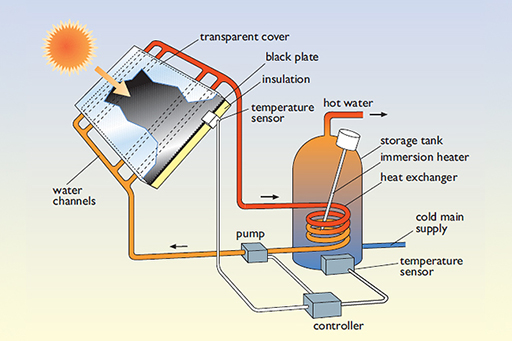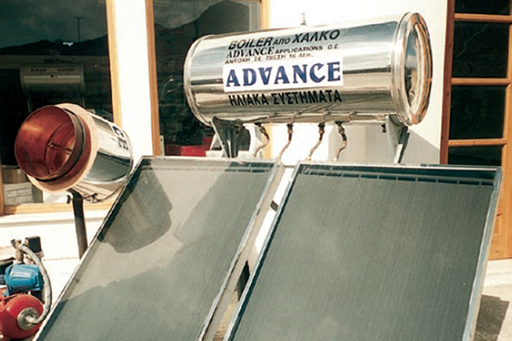5 Active solar heating
To most people, ‘solar heating’ means the familiar rooftop solar water heater, of which there are two basic forms: pumped and thermosyphon.
By the end of 2015 an estimated 622 million square metres of such solar collectors installed worldwide, a fourfold expansion since 2005. More than 70% have been installed in China. (Sawin et al., 2016). Most of these are of the simple ‘flat plate’ type, around 3–5 metres in area, mounted on the pitched roof of a house and tilted to face the Sun.

A typical pumped system as shown in Figure 11 consists of three elements:
- a collector panel, consisting of glazing, an absorber plate, and insulation
- an insulated hot water storage tank, typically of around 200 litres capacity, with hot water from the panel circulating through a heat exchanger situated at the bottom
- a pumped circulation system containing an anti-freeze (needed in northern Europe) transferring the heat from the panel to the store.
In the UK, field trial results suggest that such a system can typically provide over 1100 kWh y−1 – about 40% of a household’s hot water energy (EST, 2011)
In frost-free climates such as the Mediterranean, it is safe to mount the storage tank outdoors, so a simpler thermosyphon arrangement can be used, as shown in Figure 12.

This design dispenses with the circulation pump as it relies on the natural convection of hot water rising from the collector panel to carry heat up to the storage tank, installed above the collector. There is also no need for a heat exchanger as the required domestic hot water circulates directly through the panel. Normally the storage tank also contains an electric immersion heater for ‘topping up’ water temperature on cloudy days. Mediterranean systems are usually designed to be free-standing for mounting on buildings with flat roofs. These systems only usually require around 2 m2 of collector area due to the higher levels of solar radiation in these countries.
